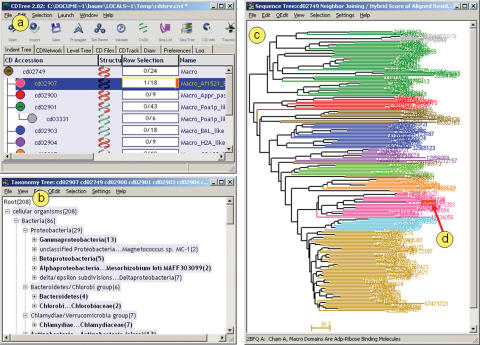Figure 2.
CDTree default display, as launched from a web browser, showing a curated domain hierarchy with an embedded user query sequence. A protein sequence found in NCBI's Entrez database was inspected for the presence of conserved domains. The user has followed links from one of the domain footprints annotated on the model, and inspected a particular domain model, cd02907. From the CD summary page, as shown in Figure 1, CDTree was launched as a helper application. The main window (a) presents the organization of the conserved domain hierarchy, as already visible on the CD summary page (Figure 1). In this case, cd02749 or ‘Macro’ is a generic ‘parent’ model, which has been split up into several more specific ‘children’. The sequence tree shown in panel (c) provides evidence for this particular subfamily structure. Groups of branches rendered in the same color correspond to alignment rows that have been assigned to a particular subgroup. Sequence trees are always calculated from the curated CD alignments; in this particular example, the distance data have been obtained from pair-wise alignment scores. Aligned residue pairs are scored with the BLOSUM62 matrix. Pair-wise scores are subtracted from the highest observed pair-wise score to yield distances, and the distance units plotted here correspond to BLOSUM62 scores. By default, a taxonomy viewer window is opened as well (b). Users may select and highlight whole branches in the sequence tree view and examine corresponding highlights in the taxonomy viewer, to understand the taxonomic scope of particular subfamilies, or select/highlight taxa in the taxonomy viewer and examine their distribution in the sequence tree. In this example, a user query sequence has been added to one of the models, cd02907. cd02907 gave the best scoring hit in a database search for a particular region of the user's query sequence. In the sequence tree display, the user query is highlighted by default (d). It appears that the user query is a typical member of this particular subfamily, as it clusters tightly with all the other members, and therefore transfer of annotation from the model to the sequence - or functional inference - may be appropriate.

